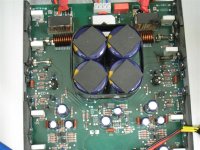I am trying to repair this amplifier. Originally when it broke. The positive and negative leads on the speaker terminals were touched together when it was on.
The two fuses inside are blown. Not sure if anything else is wrong. Not sure how to check. The one side is working. The transistors are at like 19Vpp I think. On the other one that is blown it is like 7Vpp or at least a lot less.
Any help on testing to see what is wrong or recommendations for fixing it.
Posting a few pictures below
The two fuses inside are blown. Not sure if anything else is wrong. Not sure how to check. The one side is working. The transistors are at like 19Vpp I think. On the other one that is blown it is like 7Vpp or at least a lot less.
Any help on testing to see what is wrong or recommendations for fixing it.
Posting a few pictures below
An externally hosted image should be here but it was not working when we last tested it.
An externally hosted image should be here but it was not working when we last tested it.
An externally hosted image should be here but it was not working when we last tested it.
Attachments
The fuses passed an enormous fault current judging by the blackening and missing end cap.
I suspect semiconductor and/or passives damage.
Does the transformer have a soft start?
Temporarily disable the soft start.
Start the amplifier through a mains bulb tester fitted with a 40W incandescent bulb.
Tell us what you see.
I suspect semiconductor and/or passives damage.
Does the transformer have a soft start?
Temporarily disable the soft start.
Start the amplifier through a mains bulb tester fitted with a 40W incandescent bulb.
Tell us what you see.
Actually, most of the damage to the fuse was done with a soldering iron. The fuses looked exactly like the other side but just blown right after it happened.
What would that be testing? I have to go get a bulb tester. I don't think anything is wrong with the transformer because one channel works 100%. Only one channel is out (the one that got shorted).
What would that be testing? I have to go get a bulb tester. I don't think anything is wrong with the transformer because one channel works 100%. Only one channel is out (the one that got shorted).
I doubt you will be able to buy a bulb tester.
Buy the components and assemble it yourself.
Search here or look at Nuuk's site for details. The tester does not need any switches to do it's job, these are optional add ons.
If the bad side has something approaching a short in the electronics, the fuse will simply blow again or cause further damage to the circuit.
Powering up through the bulb tester will let the amp start, but probably run at a tiny voltage, to let you start taking measurements and maybe identify the damaged components that need to be replaced.
Buy the components and assemble it yourself.
Search here or look at Nuuk's site for details. The tester does not need any switches to do it's job, these are optional add ons.
If the bad side has something approaching a short in the electronics, the fuse will simply blow again or cause further damage to the circuit.
Powering up through the bulb tester will let the amp start, but probably run at a tiny voltage, to let you start taking measurements and maybe identify the damaged components that need to be replaced.
- Status
- This old topic is closed. If you want to reopen this topic, contact a moderator using the "Report Post" button.
